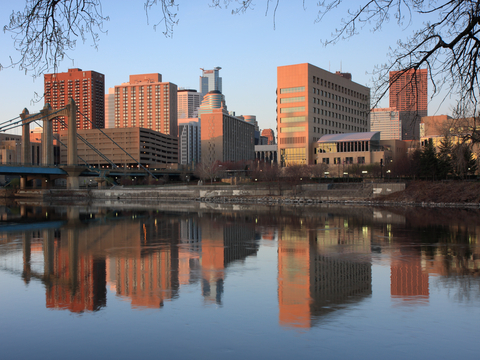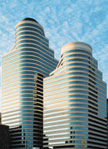
[Updated Oct 2020] A guide to executive suites and office space for rent in Minneapolis as well as general information that may be useful if you are thinking of renting offices in Minneapolis.
For further offices information or to search office space to rent in Minneapolis just click. Or contact us for any other office space query.
History & Geography
Known as the City of Lakes, Minneapolis is the largest city in the state of Minnesota and the cultural and economic hub of the region. The city sits on both banks of the Mississippi River and is joined with St Paul, the state’s capital. Together the two are known as the Twin Cities. Minneapolis has over 20 lakes in its vicinity, including the Chain of Lakes, made up of Cedar Lake, Lake Harriet, Lake Calhoun and Lake of the Isles. The area around Minneapolis was inhabited by the Dakota Sioux before Europeans came to America. French explorers were the first to discover the region in the 17th century, but it was only when the US Army built Fort Snelling in the area that the population grew. The US persuaded the local band of Dakota to sell their territory and more settlers flocked to the area. In 1867 Minneapolis was incorporated as a city. Local millers harnessed the power of Saint Anthony Falls, the largest waterfall on the Mississippi, and the city became known as ‘the greatest direct-drive water power centre the world has ever seen’. Lumber mills, fed from the forests of northern Minnesota were also a large part of the city’s economy, as were grain and flour mills. At one point Minnesota supplied ten percent of the country’s flour. However during the Great Depression in the early part of the 20th century, the city’s economy experienced a major downturn and the population suffered terribly from poverty. By 1950 though, the city had a population of 521,000 people and one of the best streetcar systems in the country. During the 1950s and 60s downtown was extensively refurbished and renovated with many old buildings torn down. Today Minneapolis is the largest business center between Chicago and Seattle and contains the fifth most Fortune 500 companies in the country.
Economy
Today Minneapolis benefits from a fairly varied economy. It is mainly made up of light industry, health care, trucking, rail, finance and commerce. Other industries have a smaller presence in the city such as technology, insurance, graphic arts, food processing and plastics and machinery. Among the Fortune 500 companies who have their headquarters in the city are Target, US Bancorp, Xcel Energy, Ameriprise Financial and PepsiAmericas. The largest employers in the city are currently the University of Minnesota, Target, Wells Fargo, Fairview Health Services, City of Minneapolis and Capella Education Company. Among the foreign companies who have a presence in the city are ING Group, Coloplast and RBC. Recently Popular Science selected Minneapolis as the ‘top tech city in the US’. Minneapolis benefits from a population that is more highly qualified than the American average, good WiFi connections, efficient transportation infrastructure, and excellent research facilities. Minneapolis and St Paul between them have a gross metropolitan product of USD 199.6 billion and a per capita personal income that ranks thirteenth in the country. The two cities provide over 60 percent of the gross state product of Minnesota. The city was hard hit by the financial crisis and the recession which followed in its wake, though there are signs of steady recovery.
Tourism & Culture
Tourism is not a major bulwark of the Minneapolis economy and most of the visitors to the city come for business rather than pleasure. However, for those who find themselves in Minneapolis with some time on their hands, there is lots to do and see. The city has a plethora of parks and lakes in its vicinity which has been called the best designed and best-maintained city park system in the country. Primary is the Chain of Lakes, a series of lakes and creeks all connected by running, walking and cycling paths. The area is used for picnics, swimming, fishing, ice skating and boating. Minneapolis also has a thriving theater scene that is considered second only to New York. Additionally, the Walker Art Centre is one of the five largest and most respected art museums in the country. The Minnesota Orchestra, under its legendary director of music Osmo Vanska, has recently been called the best in the world. Sports are also a major part of life in Minneapolis. The city’s main teams are the Vikings in American football, the Timberwolves in the NBA and the Twins in the MLB.
Transportation
The city is served by the Minneapolis-St Paul International Airport which lies to the southeast of the city. The airport is connected to downtown Minneapolis by light rail. Minneapolis itself has a public transportation system to rival almost any in the country. As well as a light commuter rail, Minneapolis also has a comprehensive bus and taxi system. The city is also known for the number of its workers who commute to work by bicycle. Every day ten thousand people cycle to work, using the city’s system of bike lanes. Minneapolis has also been named as the ninth most walkable city in the US.

Office space to rent in Minneapolis
Currently, Minneapolis has a vacancy rate of 19.2 percent, which is a decrease on previous years. The city also has a positive absorption rate of 430,000 square feet. The average rental rate is USD 21.49 per square foot which is also a decrease on previous years. Minneapolis has a little over 32 million square feet of Grade A office space and 46 million square feet of Class B and C office space. As vacancy continues to drop it is possible that rents may increase slightly some analysts have predicted.
Our office space search, advisory and acquisition services are FREE, always. Our Minneapolis office space brokers and agents are globally regulated by the Royal Institution of Chartered Surveyors (RICS) ensuring the highest standards of commercial property advice and service at all times.

The Office Providers is Regulated by the RICS